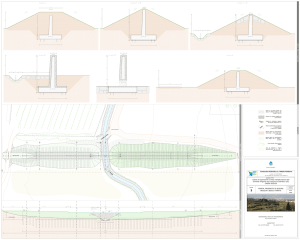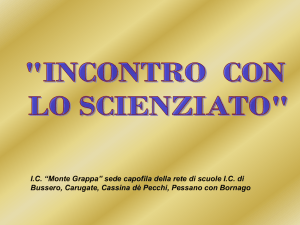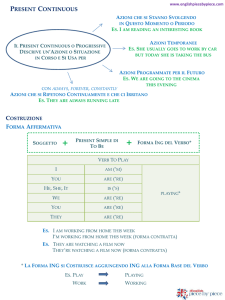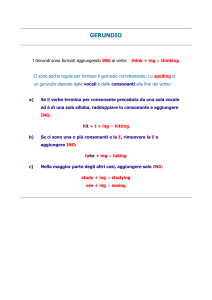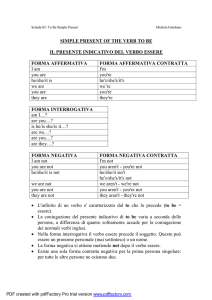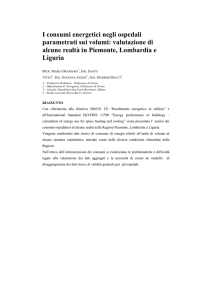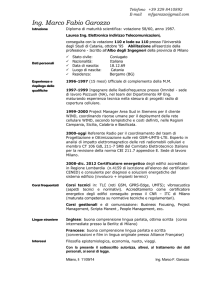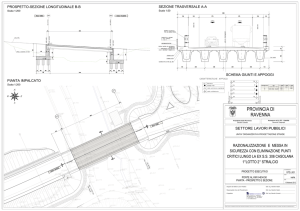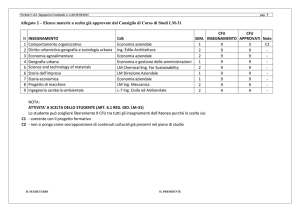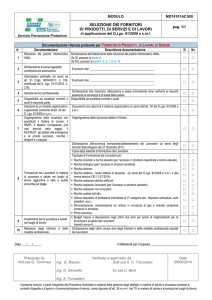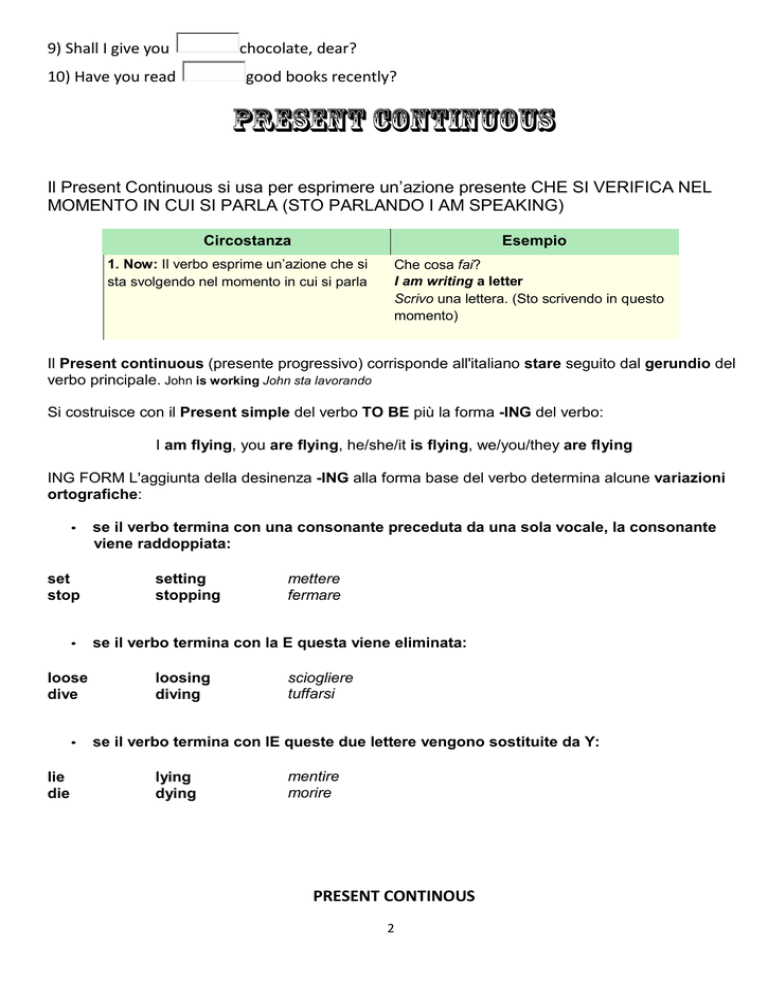
9) Shall I give you
chocolate, dear?
10) Have you read
good books recently?
PRESENT CONTINUOUS
Il Present Continuous si usa per esprimere un’azione presente CHE SI VERIFICA NEL
MOMENTO IN CUI SI PARLA (STO PARLANDO I AM SPEAKING)
Circostanza
Esempio
1. Now: Il verbo esprime un’azione che si
sta svolgendo nel momento in cui si parla
Che cosa fai?
I am writing a letter
Scrivo una lettera. (Sto scrivendo in questo
momento)
Il Present continuous (presente progressivo) corrisponde all'italiano stare seguito dal gerundio del
verbo principale. John is working John sta lavorando
Si costruisce con il Present simple del verbo TO BE più la forma -ING del verbo:
I am flying, you are flying, he/she/it is flying, we/you/they are flying
ING FORM L'aggiunta della desinenza -ING alla forma base del verbo determina alcune variazioni
ortografiche:
•
set
stop
•
loose
dive
•
lie
die
se il verbo termina con una consonante preceduta da una sola vocale, la consonante
viene raddoppiata:
setting
stopping
mettere
fermare
se il verbo termina con la E questa viene eliminata:
loosing
diving
sciogliere
tuffarsi
se il verbo termina con IE queste due lettere vengono sostituite da Y:
lying
dying
mentire
morire
PRESENT CONTINOUS
2
Verbi che si
usano al
continous
Affirmative
Negative
Interrogative
Read
leggere
I am/you are/he-she-it I am not (‘m not) /you are not (aren’t) Am I/Are you/Is he-she-it
is/we are/you are/they /he-she-it is not (isn’t)/we are not is/Are we/Are you/Are they
are reading
(aren’t) /you are not (aren’t) /they are reading?
not (aren’t) reading
Come
venire
I am/you are/he-she-it I am not (‘m not) /you are not (aren’t) Am I/Are you/Is he-she-it
is/we are/you are/they /he-she-it is not (isn’t)/we are not is/Are we/Are you/Are they
are coming
(aren’t) /you are not (aren’t) /they are coming?
not (aren’t) coming
Go andare
I am/you are/he-she-it I am not (‘m not) /you are not (aren’t) Am I/Are you/Is he-she-it
is/we are/you are/they /he-she-it is not (isn’t)/we are not is/Are we/Are you/Are they
are
ing
(aren’t) /you are not (aren’t) /they are
ing?
not (aren’t)
ing
Play giocare I am/you are/he-she-it I am not (‘m not) /you are not (aren’t) Am I/Are you/Is he-she-it
suonare
is/we are/you are/they /he-she-it is not (isn’t)/we are not is/Are we/Are you/Are they
are
ing
ing?
(aren’t) /you are not (aren’t) /they are
not (aren’t)
ing
Finish finire
I am/you are/he-she-it I am not (‘m not) /you are not (aren’t) Am I/Are you/Is he-she-it
is/we are/you are/they /he-she-it is not (isn’t)/we are not is/Are we/Are you/Are they
are
ing
(aren’t) /you are not (aren’t) /they are
ing?
not (aren’t)
ing
Get
ottenere
I am/you are/he-she-it I am not (‘m not) /you are not (aren’t) Am I/Are you/Is he-she-it
is/we are/you are/they /he-she-it is not (isn’t)/we are not is/Are we/Are you/Are they
(aren’t) /you are not (aren’t) /they are
ing?
are
ing
not (aren’t)
ing
Give dare
I am/you are/he-she-it I am not (‘m not) /you are not (aren’t) Am I/Are you/Is he-she-it
is/we are/you are/they /he-she-it is not (isn’t)/we are not is/Are we/Are you/Are they
are
ing
(aren’t) /you are not (aren’t) /they are
ing?
not (aren’t)
ing
Learn
imparare
I am/you are/he-she-it I am not (‘m not) /you are not (aren’t) Am I/Are you/Is he-she-it
is/we are/you are/they /he-she-it is not (isn’t)/we are not is/Are we/Are you/Are they
are
ing
(aren’t) /you are not (aren’t) /they are
ing?
3
ing
not (aren’t)
Listen
ascoltare
I am/you are/he-she-it I am not (‘m not) /you are not (aren’t) Am I/Are you/Is he-she-it
is/we are/you are/they /he-she-it is not (isn’t)/we are not is/Are we/Are you/Are they
are
ing
ing?
(aren’t) /you are not (aren’t) /they are
not (aren’t)
ing
Look at
I am/you are/he-she-it I am not (‘m not) /you are not (aren’t) Am I/Are you/Is he-she-it
is/we are/you are/they /he-she-it is not (isn’t)/we are not is/Are we/Are you/Are they
are
ing
(aren’t) /you are not (aren’t) /they are
ing at?
not (aren’t)
ing at
at
guardare
Sell
vendere
I am/you are/he-she-it I am not (‘m not) /you are not (aren’t) Am I/Are you/Is he-she-it
is/we are/you are/they /he-she-it is not (isn’t)/we are not is/Are we/Are you/Are they
are
ing
(aren’t) /you are not (aren’t) /they are
ing?
not (aren’t)
ing
Speak
parlare
I am/you are/he-she-it I am not (‘m not) /you are not (aren’t) Am I/Are you/Is he-she-it
is/we are/you are/they /he-she-it is not (isn’t)/we are not is/Are we/Are you/Are they
(aren’t) /you are not (aren’t) /they are
ing?
are
ing
not (aren’t)
ing
Stop
fermare
I am/you are/he-she-it I am not (‘m not) /you are not (aren’t) Am I/Are you/Is he-she-it
is/we are/you are/they /he-she-it is not (isn’t)/we are not is/Are we/Are you/Are they
are
ing
(aren’t) /you are not (aren’t) /they are
ing?
not (aren’t)
ing
Study
studiare
I am/you are/he-she-it I am not (‘m not) /you are not (aren’t) Am I/Are you/Is he-she-it
is/we are/you are/they /he-she-it is not (isn’t)/we are not is/Are we/Are you/Are they
are
ing
ing?
(aren’t) /you are not (aren’t) /they are
not (aren’t)
ing
Watch
vedere
I am/you are/he-she-it I am not (‘m not) /you are not (aren’t) Am I/Are you/Is he-she-it
is/we are/you are/they /he-she-it is not (isn’t)/we are not is/Are we/Are you/Are they
are
ing
(aren’t) /you are not (aren’t) /they are
ing?
not (aren’t)
ing
Write
scrivere
I am/you are/he-she-it I am not (‘m not) /you are not (aren’t) Am I/Are you/Is he-she-it
is/we are/you are/they /he-she-it is not (isn’t)/we are not is/Are we/Are you/Are they
are
ing
ing?
(aren’t) /you are not (aren’t) /they are
not (aren’t)
ing
4
Ask
domandare
I am/you are/he-she-it I am not (‘m not) /you are not (aren’t) Am I/Are you/Is he-she-it
is/we are/you are/they /he-she-it is not (isn’t)/we are not is/Are we/Are you/Are they
are
ing
ing?
(aren’t) /you are not (aren’t) /they are
not (aren’t)
ing
Change
cambiare
I
Close
chiudere
I
Cry
piangere
I
Do fare
I
Drink bere
I
Laugh
ridere
I
, you , he-she-it I am not (‘m not) /you are not (aren’t) Am I/Are you/Is he-she-it
, we , you
, /he-she-it is not (isn’t)/we are not is/Are we/Are you/Are they
they
ing
(aren’t) /you are not (aren’t) /they are
ing?
not (aren’t)
ing
, you , he-she-it I am not (‘m not) /you are not (aren’t) Am I/Are you/Is he-she-it
, we , you
, /he-she-it is not (isn’t)/we are not is/Are we/Are you/Are they
they
ing
ing?
(aren’t) /you are not (aren’t) /they are
not (aren’t)
ing
, you , he-she-it I am not (‘m not) /you are not (aren’t) Am I/Are you/Is he-she-it
, we , you
, /he-she-it is not (isn’t)/we are not is/Are we/Are you/Are they
they
ing
ing?
(aren’t) /you are not (aren’t) /they are
not (aren’t)
ing
, you , he-she-it I am not (‘m not) /you are not (aren’t) Am I/Are you/Is he-she-it
, we , you
, /he-she-it is not (isn’t)/we are not is/Are we/Are you/Are they
(aren’t) /you are not (aren’t) /they are
ing?
they
ing
not (aren’t)
ing
, you , he-she-it I am not (‘m not) /you are not (aren’t) Am I/Are you/Is he-she-it
, we , you
, /he-she-it is not (isn’t)/we are not is/Are we/Are you/Are they
they
ing
(aren’t) /you are not (aren’t) /they are
ing?
not (aren’t)
ing
, you , he-she-it I am not (‘m not) /you are not (aren’t) Am I/Are you/Is he-she-it
, we , you
, /he-she-it is not (isn’t)/we are not is/Are we/Are you/Are they
they
ing
ing?
(aren’t) /you are not (aren’t) /they are
not (aren’t)
ing
Open aprire I am/you are/he-she-it I
is/we are/you are/they
are
ing
/they
/you
/we
/he-she-it
_/you
ing
Am I/Are you/Is he-she-it
is/Are we/Are you/Are they
ing?
Park
parcheggiar
e
I am/you are/he-she-it I
is/we are/you are/they
are
ing
/they
/you
/we
/he-she-it
_/you
ing
Am I/Are you/Is he-she-it
is/Are we/Are you/Are they
ing?
Pay pagare
I am/you are/he-she-it I
is/we are/you are/they
are
ing
/they
/you
/we
/he-she-it
_/you
ing
Am I/Are you/Is he-she-it
is/Are we/Are you/Are they
ing?
5
Send
mandare
spedire
I am/you are/he-she-it I
is/we are/you are/they
are
ing
/they
/you
/we
/he-she-it
_/you
ing
Am I/Are you/Is he-she-it
is/Are we/Are you/Are they
ing?
Start
iniziare
I am/you are/he-she-it I
is/we are/you are/they
are
ing
/they
/you
/we
/he-she-it
_/you
ing
Am I/Are you/Is he-she-it
is/Are we/Are you/Are they
ing?
Take
prendere
I am/you are/he-she-it I
is/we are/you are/they
are
ing
/they
/you
/we
/he-she-it
_/you
ing
Am I/Are you/Is he-she-it
is/Are we/Are you/Are they
ing?
Try cercare
trovare
I am/you are/he-she-it I am not (‘m not) /you are not (aren’t)
I/
is/we are/you are/they /he-she-it is not (isn’t)/we are not is/
are
ing
(aren’t) /you are not (aren’t) /they are they
not (aren’t)
ing
Visit
visitare
I am/you are/he-she-it I am not (‘m not) /you are not (aren’t)
I/
is/we are/you are/they /he-she-it is not (isn’t)/we are not is/
are
ing
(aren’t) /you are not (aren’t) /they are they
not (aren’t)
ing
you/
he-she-it
we/
you/
ing?
Wait
aspettare
I am/you are/he-she-it I am not (‘m not) /you are not (aren’t)
I/
is/we are/you are/they /he-she-it is not (isn’t)/we are not is/
are
ing
(aren’t) /you are not (aren’t) /they are they
not (aren’t)
ing
you/
he-she-it
we/
you/
ing?
Walk
camminare
I am/you are/he-she-it I am not (‘m not) /you are not (aren’t)
I/
is/we are/you are/they /he-she-it is not (isn’t)/we are not is/
are
ing
(aren’t) /you are not (aren’t) /they are they
not (aren’t)
ing
you/
he-she-it
we/
you/
ing?
you/
he-she-it
we/
you/
ing?
1. SU PRESENT SIMPLE E CONTINUOUS
1.Completa le seguenti frasi scegliendo la forma verbale corretta fra le due date:
1. Look! That man …………. the old lady (is robbing/robs)
2. My brother always ……………… tennis on Saturdays (plays/is playing)
3. When we …………. to the disco, we ………….. back home very late (go/are going) (come/are
coming)
6
4. I have got so many doubts. I ……………… to call and tell her the whole truth
(think/am/thinking)
5. You often ……………….. tv in the evening, because you love films (watch/are watching)
6. Mary is a very good pianist. Listen, now she ………………… Mozart (plays/is playing)
7. We can’t come with you, sorry. We …………… for our English test (study/are studying)
8. Don’t call them now! It’s 8 o’clock and they ………………. dinner (have/are having)
9. We are not lucky. If we ……….. to go out for a walk, it always ……… (decide/are deciding)
(rains/is raining)
10. You won’t find him home today. He …………… to England (travels/is travelling)
2. Put the verb into the correct form (present simple or continuous)
1) “How
(to be) your French?” “Not bad. It
2) Look! The train
(to leave)!
3) The train
(to leave) at 9 o'clock.
4) “What time
5) If you
(improve).
(you/get) up in the morning?”“I usually
(to get up) at 7.
(to study), you'll pass your exam.
6) The man we met yesterday
7) The young man
8) I must go now. It
9) This room
(to be) on TV!
(to paint) a beautiful picture!
(to get) late!
(to smell). Let's open the window.
10) Don't go out, it
(rain).
PLACE PREPOSITIONS
Preposizioni di
luogo
IN
AT
Quando si usa
Esempio
In si usa normalmente per esprimere il
concetto di all’interno di…, per indicare
una posizione in uno spazio in qualche
modo delimitato, anche se non ha un
preciso confine fisico:
I live in Italy.
Vivo in Italia.
I live in Rome.
Vivo a Roma.
At ha un significato più generale di in. Lo
si usa con:
Casa, ufficio,
scuola etc. intesi non come edifici fisici,
ma come luogo dove si vive, si lavora, si
studia
He is at home.
Egli è a casa
TO
Ci si sposta verso un luogo preciso.
I’m going to Rome.
Sto andando a Roma.
INTO
Si entra in un luogo chiuso, o in qualche
modo delimitato (all’interno di…).
He went into the house.
Entrò in casa.
FROM
La preposizione from esprime sia il
complemento di moto da luogo (vengo
The train from London arrived 5 minutes
ago.
7
At the North Pole
Al Polo Nord
da…) che quello di origine (sono
originario di…).
Il treno da Londra è arrivato 5 minuti fa.
ON
Sopra, riferito ad una superficie, quando
c’è contatto fisico.
The book is on the desk.
Il libro è sulla scrivania.
UNDER
Sotto
The cat is under the table.
Il gatto è sotto il tavolo.
NEAR
Vicino a…
I live near here.
Abito qui vicino.
NEXT TO
Accanto a…(confinante con…)
Sarah is sitting next to Robert.
Sarah è seduta vicino a Robert.
BETWEEN
Fra due cose o persone.
Susan is sitting between Mary and John.
Susan è seduta fra Mary e John.
OPPOSITE
Di fronte a…, dal lato opposto rispetto ad
una strada, un corridoio etc.
The car is parked opposite the house.
L’auto è parcheggiata di fronte alla casa (dal
lato opposto della strada).
IN FRONT OF
Davanti a…
The car is parked in front of the house.
L’auto è parcheggiata davanti alla casa (sullo
stesso lato della strada).
THROUGH
Attraverso, da una parte all’altra di
qualcosa di chiuso o delimitato.
He got in through the window.
Entrò attraverso la finestra.
BEHIND
Dietro
Who is sitting behind John?
Chi è seduto dietro a John?
1. Complete the sentences using
1) I’m going
IN - AT - ON - INTO - TO - OVER - INSIDE place
London. I'll study
2) The dog was sitting
3) We live
floor!
Paris.
4) Where are you? I’m waiting for you
5) Put my wallet
6) The jam is
the station.
your bag, please.
the cupboard.
7) The airplane is flying
8) Would you like to come
9) Go
the Royal College of Art.
the lake.
the cinema with me?
bed!
10) I put the bags
the car and went away.
8
DIRECTIONS
LEFT SINISTRA
how far is it?
Where is the
RIGHT DESTRA
STRAIGHT ON DRITTO
quanto dista?
Dov’è?
?
TURN LEFT GIRARE A SINISTRA
GO STRAIGHT ON
TURN RIGHT GIRARE A DESTRA
ANDARE DRITTO
FRASE
Excuse me, where’s the [station],
please?
Excuse me, is there a [pub] near
here?
Excuse me, where’s the nearest
[pub]?
Excuse me, can/could you tell me
the way to the [station]?
SIGNIFICATO
Mi scusi, dove è la stazione
per favore?
Mi scusi, c’è un pub nelle
vicinanze?
Mi scusi, dov’è il pub più
vicino?
Mi scusi mi può/potrebbe
dire la strada per la
stazione?
Excuse me, how do/can I get to the Mi scusi, come ci arrivo
alla stazione?
[station]?
Giri a destra/sinistra in Gin
Turn right/left (into [Gin Street]
Street
Take the first/second… (turning) Prenda la prima/seconda
(strada) a destra/sinistra
on the right/left
Vada a diritto fino al
Go straight on/ahead (as far as
semaforo
[the traffic light])
Go/Walk down/along this/[Gin]
street ahead (as far as [the traffic
light])
Cross Gin street
Go past the [theatre]
The [pub] is at the end/beginning
of the street on your right/left
The [pub] is halfway down the
street
Prosegua / Continui a
camminare per questa
strada/Gin street fino al
semaforo
Attraversi Gin Street
Oltrepassi il teatro
Il pub è alla fine/all’inizio
della strada sulla sua
destra/sinistra
Il pub è a metà della strada
9
NOTE
Si noti l’uso di “Excuse me” per attirare
l’attenzione
“Go straight on/ahead” non può essere
seguito direttamente dal nome della
strada, come, ad es., “Go straight on
Gin Street”
PLACES IN THE CITY
1.- Write the correct preposition.- (far from - near from - beside - behind - between - across from)
Where is the police station
the bank and the store.
Where is the movie theater? The movie theater is
the restaurant.
10
Where is the store? The store is
the police station.
Where is the train station? The train station is
Where is the hospital? The hospital is
Where is the school? The school is
the bank.
the church.
the drugstore.
2.- Choose the correct option from the box.-
The restaurant is between the bank and the hotel.
The supermarket is across from the train station.
The school is in front of the police station.
YOU ARE AT THE X POINT.-
Follow the directions and write the name of the place inside the box, use the names of the places above.
Walk straight one block, turn left on Apple Street, it's on the corner of Apple
Street and First Avenue.
Walk straight ahead on Second Avenue, turn left on Main Street,
walk one block, get to the train station and cross the street.
Walk straight, turn left
on Apple Street walk for one block, then turn right and walk one block on First Ave., then turn right
on Main street. It's next to the the bank .
11
SCHOOLS IN THE
UNITED KINGDOM
In United Kingdom the school is compulsory as in Italy, but children start school when they are five
and they continue until sixteen. There are public school (scuole private) where the parents must pay
or private school (scuole statali).
From 2 (two) to 5 (five) children can attend Nursery School where they play and sing. This school
is not compulsory as Scuola Materna in Italy.
From 5 to 11 children must attend Primary School: Primary school is divided in Infant School (
from 5 to 7 years) in which children learn reading, writing and in Junior School (from 7 to 11)
where children study, English, maths, geography, history, technology, music and art.
At Secondary school (from 11 to 16 or 18) children study English, maths, science, history,
geography, music, art, physical education and a foreign language (generally French). They can also
study extra subjectas like computer, cookery, woodworks. Sport is alsop very important in British
schools. When the students are sixteen they must take a national examination (GCSE General
Certificate of Secondary Education) generally in 6 or 7 subjects they chose. The GCSE is the end of
compulsory education,
Then children can stop studying or they can attend two years. It’s important having a GCSE A or B
level results. Then students can attend University.
FACULTATIVE
COMPULSORY
COMPULSORY
NURSERY SCHOOL (2-5)
SCUOLA MATERNA (3-6)
PRIMARY SCHOOL
SCUOLA
PRIMARIA
o
INFANT SCHOOOL (5-7)
ELEMENTARE
JUNIOR SCHOOL (7-11)
(6-11)
SECONDARY SCHOOL OR SCUOLA MEDIA (11-14)
COLLEGE (11-16)
COLLEGE (16-18)
SCUOLA SUPERIORE (14-19)
UNIVERSITY (18-22)
Prof. Massimiliano Badiali
UNIVERSITA’ (19-24)
GRADED EXAMINATIONS IN SPOKEN ENGLISH
LEVEL: BEGINNERS
QUADRO EUROPEO DELLE LINGUE: LIVELLO A1 GRADE 1
1. What’s your name?
My name is/ I am………………………….
2. How do you spell your name?
………………………………….
3. What’s your surname?
My surname is/It’s……………...
4. How do you spell your surname?
……………………………………………….
5. What’s your nickname?
My nickname is/ It’s………………………….
6. How are you?
Fine, thank you.
7. How old are you?
I’m ……. years old.
8. Where do you come from?
I’m from Italy.
9. Where are you from?
I am (come) from………..
10. What shape is this?
It’s a……………………….
11. Where do you live?
I live in…………………..
12. What’s your telephone number?
My telephone number is/ It’s ……………
13. What’s your favourite colour?
My favourite colour is/ It’s ……………………
14. What colour is your T-Shirt (blouse etc)
It’s………………………………………
15. What are you wearing?
I’m wearing……………………………..
16. What day is it on?
It’s…………………………………..
17. What month is it on?
It’s……………………………………
18. What season is it on?
It’s…………………………………..
19. Can you touch your nose/mouth/ear/hair/eyes
20. Stop talking/shut up/be quiet/be silent
21. Can I go to the toilet, please?
Yes, you can or No, you can’t
22. Are you…..?
Yes, I am……/No, I am not
23. What colour is that (this)?
It’s………………….
24. What’s your favourite food?
My favourite food is/ It’s ………………………
25. What’s your favourite drink?
My favourite drink is/ It’s ………………………
26. What’s your favourite animal?
My favourite animal is/ It’s …………………..
27. What’s your favourite school subject? My favourite school subject is/ It’s ……………
28. When is the English lesson?
It’s on ________at __________ , on
____________ at__________________ and on ____________ at__________________
29. What school subjects do you like?
I like………………………………..
30. What subjects do you study at school?
I study Italian, English, Maths……
31. What’s the weather like?
It’s cold/hot/sunny/cloudy oppure It rains o It snows
32. What’s your mother’s name?
My mother’s name is/ It’s …………………..
33. What’s your father’s name?
My father’s name is/ It’s …………………..
34. Who’s your best friend?
My best friend is……………..
Prof. Massimiliano Badiali Copyright 2001-2012 all right reserved
TRINITY EXAMINATIONS IN SPOKEN ENGLISH
COUNTRIES-NATIONS AND NATIONALITIES
Country – Paese
Adjective
Nationality – Nazionalità-
Inhabitant
Denmark
Danimarca
Danish
Danish
danese
Dane
England
Inghilterra
English
British / English
inglese
Englishman /
Englishwoman
Finland
Finlandia
Finnish
Finnish
finlandese
Finn
Iceland
Islanda
Icelandic
Icelandic
Icelander
Ireland
Irlanda
Irish
Irish
irlandese
Irishman / Irishwoman
Northern Ireland
Irlanda del Nord
Northern Irish
British / Northern Irish
irlandese del nord
Northern Irishman /
Northern Irishwoman
Norway
Norvegia
Norwegian
Norwegian
norvegese
Norwegian
Scotland
Scozia
Scottish
British / Scottish
scozzese
Scot / Scotsman /
Scotswoman
Sweden
Svezia
Swedish
Swedish
svedese
Swede
United Kingdom (spesso
abbreviato in UK)
Regno Unito
British
British
Briton
(rarely used in
conversation)
Wales
Galles
Welsh
British / Welsh
gallese
Welshman / Welshwoman
Austria
Austria
Austrian
Austrian
austriaco
Austrian
Belgium
Belgio
Belgian
Belgian
belga
Belgian
France
Francia
French
French
francese
Frenchman /
Frenchwoman
Germany
Germania
German
German
tedesco
German
Netherlands
Paesi bassi (Olanda)
Dutch
Dutch
olandese
Dutchman / Dutchwoman
Switzerland
Svizzera
Swiss
Swiss
svizzero
Swiss
Albania
Albania
Albanian
Albanian
Albanian
Croatia
Croazia
Croatian
Croatian
Croatian
Greece
Grecia
Greek
Greek
greco
Greek
Italy
Italia
Italian
Italian
italiano
Italian
Portugal
Portogallo
Portuguese
Portuguese
portoghese
Portuguese
Spain
Spagna
Spanish
Spanish
spagnolo
Spaniard
Bulgaria
Bulgarian
Bulgarian
Bulgarian
1
Czech Republic
Repubblica Ceca
Czech
Czech
ceco
Czech
Hungary
Ungheria
Hungarian
Hungarian
ungherese
Hungarian
Poland
Polonia
Polish
Polish
polacco
Pole
Romania
Romania
Romanian
Romanian
Romanian
Russia
Russia
Russian
Russian
russo
Russian
Canada
Canada
Canadian
Canadian
candese
Canadian
Mexico
Messico
Mexican
Mexican
messicano
Mexican
United States (spesso
abbreviati in US o USA)
Stati Uniti
American
American
americano
American
Argentina
Argentina
Argentine / Argentinian
Argentine / Argentinian
argentino
Argentine / Argentinian
Brazil
Brasile
Brazilian
Brazilian
brasiliano
Brazilian
Turkey
Turchia
Turkish
Turkish
turco
Turk
India
India
Indian
Indian
indiano
Indian
China
Cina
Chinese
Chinese
cinese
Chinese
Japan
Giappone
Japanese
Japanese
giapposese
Japanese
Philippines
Filippine
Filipino
Filipino
Filipino
Australia
Australia
Australian
Australian
australiano
Australian
New Zealand
Nuova Zelanda
New Zealand
New Zealand
neozelandese
New Zealander
neozelandese
Algeria
Algeria
Algerian
Algerian
Algerian
Egypt
Egitto
Egyptian
Egyptian
egiziano
Egyptian
Libya
Libia
Libyan
Libyan
Libyan
Morocco
Marocco
Moroccan
Moroccan
Moroccan
Tunisia
Tunisia
Tunisian
Tunisian
Tunisian
Ethiopian
Ethiopian
Ethiopian
South African
South African
sudafricano
South African
Ethiopia
Etiopia
South Africa
Sudafrica
2
Opposites - Adjectives
Adjectives
Opposites
alive
dead
beautiful
ugly
big
small
bitter
sweet
cheap
expensive
clean
dirty
curly
straight
difficult
easy
good
bad
early
late
fat
thin
full
empty
hot
cold
happy
sad/unhappy
hardworking
lazy
modern
traditional
new
old
nice
nasty
intelligent
stupid
interesting
boring
light
heavy
polite
rude/impolite
poor
rich
quiet
noisy
right
wrong
safe
dangerous
short
long
small
big
soft
hard
single
married
true
false
white
black
3
How much?
"How much" d’altro canto, puoi tradurlo in Italiano con "Quanto". Questa domanda é sempre usata, quando la
quantità non può essere misurata esattamente o rappresentata tramite un numero. Puoi rispondere per esempio
con: "not so much" o "three tea spoons".
How much time is there?
Quanto tempo é?
How much water are you drinking?
Quanta acqua stai bevendo?
PRICE-PREZZO
How much does it cost? How much is it? How much?
quanto costa?
Si risponde con
It costs /It is_____________
Ex 10,60 It’s ten euro sixty
Euro si dice iuro, i centesimi cent (sent)
Euro is the official coin in Northern Ireland
IN EURO 3,50_________________________ 10,45_________________100____________
Sterlina si dice pound (paund) i centesimi si dicono pence 1 cent. penny
Pound is the official coin in United Kingdom
IN POUND 2,30_________________________ 20,35_________________12,01____________
Dollaro si dice dollar i centesimi cent
Dollar is the official coin in United States of America
IN DOLLAR 23,70_______________________50,15_________________45,60____________
(prezzo) cost, price;
(per un servizio) fee, charge;
(spesa) cost, expense;
a prezzo di ~ [vendere] at cost (price);
a basso ~ [vendere, comprare] on the cheap;
[film, produzione] low-budget, low-cost;
sotto ~ [vendere, comprare] below cost, under price
8
COMMONWEALTH OF NATIONS
The Commonwealth of Nations, normally referred to as the Commonwealth and formerly known
as the British Commonwealth, is an intergovernmental organisation of 54 independent
member states, BRITAIN EX COLONIES. The member states cooperate within a framework of
common values and goals, as outlined in the Singapore Declaration. These include the promotion of
democracy, human rights, good governance, the rule of law, individual liberty, egalitarianism,
Commonwealth
free trade, multilateralism
and
world
peace.[1] The
is
not
a
political
union, but an intergovernmental
organisation in which countries with diverse social, political and economic backgrounds are
regarded as equal in status. The symbol of their free association is the Head of the
Commonwealth, which is held by Queen Elizabeth II.
REALMS
Commonwealth
members,
COMMONWEALTH
Elizabeth II is also monarch, separately and independently, of 16
which
are
known
as
the
"Commonwealth
realms".
A Commonwealth realm is a sovereign state within the Commonwealth of Nations that has Elizabeth
II as its monarch and head of state. The biggest realms are: the United Kingdom, Canada, Australia,
Papua New Guinea and Jamaica.
13
ENGLISH SPEAKING COUNTRIES
English, a West Germanic language that is named for its origins as the native tongue of the people of
England, is the most widely used language in the world . It is the third most commonly spoken
language in the world in terms of native speakers, after Mandarin Chinese and Spanish.] But it is more
commonly used as a second language than any other exceeds those of any other language.
English is one of the official
languages of the United Nations, European Union and the International Olympic Committee.
ENGLISH AS FIRST LANGUAGE It is spoken as a first language by a majority of the
inhabitants of several nations, including the United Kingdom, the United States, Canada, Australia,
Ireland and New Zealand Anguilla, Antigua and Barbuda, Bahamas, Barbados, Belau, Belize, British
Virgin Islands, Cayman Islands, Dominica, Federation of Micronesia, Grenada, Guam, Guyana,
Jamaica, Johnston, Montserrat, Northern Marianas, St. Kitts and Nevis, St. Lucia, St. Vincent &
Grenadines, Trinidad and Tobago, Turks and Caicos Islands, and the United States Virgin Islands.
ENGLISH OFFICIAL LANGUAGE OR SECOND LANGUAGE A number of
countries use English as an official language Botswana, Fiji, Ghana, Kenya, India, Hong Kong,
Lesotho, Liberia, Malawi, Malaysia, Malta, Mauritius, Nigeria, Pakistan, Philippines, Rwanda,
Seychelles, Sierra Leone, Samoa, Singapore, South Africa, Sri Lanka, Swaziland, Tanzania, Tonga,
Uganda, Zimbabwe and Zambia.
14
SIMPLE PAST
Il Simple Past è il tempo verbale inglese che esprime il concetto generale di un’azione che si è
svolta nel passato e non ha più nessun rapporto con il presente.
Per poter mettere un verbo al Simple Past devono verificarsi contemporaneamente tre condizioni.
1. L’azione deve essersi svolta nel passato ed essere finita nel momento in cui si parla.
2. Il tempo in cui l’azione si è svolta deve essere espresso nella frase o nel contesto.
Ho visto quel film.
L’azione di vedere il film è passata e finita, perché in questo momento
non lo sto più guardando, ma il tempo in cui si è svolta non è espresso:
non dico quando ho visto il film. Perciò il verbo "vedere" non può
essere messo al Simple Past in inglese.
I have seen that movie.
3. Il tempo espresso deve essere passato e finito mentre si parla.
Ho visto quel film questa
settimana
Il tempo è espresso, questa settimana, ma la settimana non è
ancora finita, perciò non posso usare il Simple Past.
I have seen that movie this week.
Ho visto quel film la settimana L’azione è passata (1° condizione).
scorsa
Il tempo è espresso (2° condizione).
Il tempo espresso è finito (3° condizione).
>>> Devo mettere il verbo al Simple Past.
I saw that movie last week.
Le espressioni di tempo che collocano l’azione in un momento definito del passato possono essere
di diverso tipo.
Posso esprimere il tempo
mediante
Esempio
•
Avverbi di tempo.
Yesterday (ieri)
•
Complementi di tempo
Last week (la settimana scorsa)
During my summer holidays
(durante le mie vacanze estive)
Three days ago (tre giorni fa)
1
•
Proposizioni temporali
When I was a child (quando ero bambino)
When I was three years old
(quando avevo tre anni)
•
Un evento storico
During World War II
(durante la seconda guerra mondiale)
Nota
Si usa il Simple Past anche in assenza di espressione di tempo passato, nei seguenti casi:
Circostanza
•
•
•
Esempio
Nelle domande al passato
con WHEN, perché si
presuppone nella risposta
la collocazione dell’azione
in un momento preciso del
passato.
Quando hai visto quel film?
Nelle proposizioni
temporali introdotte da
WHEN
Quando lo conobbi…..
Quando si parla di una
persona che non vive più.
Shakespeare scrisse molte opere teatrali.
When did you see that movie?
When I first met him …..
Shakespeare wrote many plays.
Come si costruisce
Il Simple Past, nella forma affermativa, è un tempo semplice, che è dato dalla seconda voce del
paradigma ed è uguale per tutte le persone.
Infinito italiano
Paradigma inglese
Lavorare
work - worked - worked
Andare
go - went - gone
Per i verbi regolari il Simple Past si ottiene aggiungendo -ED alla forma base del verbo, tenendo
presente quanto segue.
Regola
Forma Base
Simple Past
I verbi regolari aggiungono ed alla
forma base
work (lavorare)
worked
walk (camminare)
walked
2
I verbi che terminano per -e
aggiungono solo la d
smile (sorridere)
smiled
I verbi che terminano per -y
cry (piangere)
preceduta da consonante, cambiano
la y in i e aggiungono ed.
cried
I verbi che terminano per una sola
consonante preceduta da una
vocale accentata raddoppiano la
consonante finale.
admit (ammettere)
admitted
stop (fermarsi)
stopped
I verbi che terminano per -l
preceduta da una sola vocale
raddoppiano sempre la l.
travel (viaggiare)
travelled
Per i verbi irregolari il paradigma è dato dal dizionario, e bisogna
impararlo a memoria (vedi paradigma dei verbi irregolari).Esempio:
Infinito italiano
Paradigma inglese
essere
be - was - been
andare
go - went - gone
correre
run - ran - run
avere
have - had - had
TO BE
I, he, she, it
was.
you, we, they were.
Examples: I was in London in 1999.
The interrogative form:
Was
I, he, she, it?
Were you, we, they?
Examples: Were you in London last year?
The negative form:
I, you, he, she
was not.
wasn't.
You, we, they were not.
3
weren't.
Essendo un tempo semplice, il Simple Past dei verbi non-ausiliari ha bisogno dell’aiuto di un ausiliare
per fare le forme interrogative e negative. Si usa l’ausiliare DID, in presenza del quale il verbo dalla
frase resta invariato nella sua forma base.
Forma
Forma
affermativa
Costruzione
Esempio
SOGGETTO + 2° VOCE
DEL PARADIGMA
I worked
you worked
he / she / it worked
we worked
you worked
they worked
Forma
interrogativa
DID + SOGGETTO +
FORMA BASE
Did you work last night?
(Hai lavorato ieri sera?)
Forma negativa
SOGG. + DID + NOT +
FORMA BASE
I didn’t work last night
(Non ho lavorato ieri sera)
DID NOT>>>DIDN’T
Nota:
Ieri mattina
Yesterday morning
Ieri pomeriggio
Yesterday afternoon
Ieri sera
Yesterday evening
Ieri notte / sera tardi
Last night
IRREGULAR VERBS
GROUP 1 (A,B ;B)
Infinitive
Simple Past
Past Participle
bring
brought
brought
build
built
Built
4
burn
burnt/ burned
burnt/burned
bought
Bought
caught
Caught
dreamt/ dreamed
Dreamt/ dreamed
Fight
fought
Fought
find
found
Found
Forbid
forbade
Forbidden
Have
had
Had
hear
heard
Heard
Keep
kept
Kept
learn
learnt
Learnt
leave
left
Left
lose
lost
Lost
make
made
made
mean
meant
meant
meet
met
met
pay
paid
Paid
say
said
said
sell
sold
sold
send
sent
sent
show
showed
shown / showed
sit
sat
sat
spend
spent
spent
buy
catch
Dream
5
teach
taught
taught
tell
told
told
think
thought
Thought
Wake
Woke-waked
Woken-waked
Win
won
won
GROUP 2 (A;B;C)
Infinitive
Simple Past
Past Participle
Be
was / were
been
bear
Bore
born / borne
beat
Beat
beaten / beat
become
Became
become
begin
began
begun
bite
bit
bitten
Break
broke
Broken
chose
Choose
Chosen
do
did
done
drink
drank
drunk
drive
drove
driven
eat
ate
eaten
fall
fell
fallen
feed
fed
fed
feel
felt
felt
forget
forgot
forgotten
forgive
forgave
forgiven
freeze
froze
frozen
6
get
got
gotten/ got
give
gave
given
go
went
gone
grow
grew
grown
know
knew
known
read
read (sounds like "red")
read (sounds like "red")
see
saw
seen
sing
sang
sung
speak
spoke
spoken
steal
stole
stolen
swim
swam
swum
take
took
taken
wear
wore
worn
write
wrote
written
GROUP 3 /A,A;A)
Infinitive
Simple Past
Past Participle
cost
cost
cost
cut
cut
cut
let
let
let
put
put
put
set
set
set
GROUP 4 (A, B, A)
Infinitive
Simple Past
Past Participle
become
became
become
come
came
come
7
run
ran
run
EXERCISES
Put the verb "to be" into the simple past:
1. I
in Canada last summer holiday.
2. My sister
with me.
3. We
in Montreal.
4. She
very happy.
5. I
happy, too.
Put the verb "to be" into the simple present or the simple past:
1. I
an engineer.
2. Last year I
3. I
a student in Massachusetts Institute of Technology.
in love with a beautiful girl at that time.We
4. Now, I live in New York and I
friends
married to her.
Put the verbs into the simple past:
1. Last year I (go)
to England on holiday.
2. It (be)
fantastic.
3. I (vist)
lots of interesting places. I (be)
4. In the mornings we (walk)
in the streets of London.
5. In the eveninigs we (go)
6. The weather (be)
to pubs.
strangely fine.
7. It (not / rain)
a lot.
8. But we (see)
some beautiful rainbows.
9. Where (spend / you)
your last holiday?
Write the past forms of the irregular verbs.
Infinitive
1.
meet
2.
drive
3.
speak
4.
put
Simple Past
.
.
.
.
8
with two friends of mine .
5.
write
6.
sing
7.
do
8.
sit
9.
stand
10.
run
.
.
.
.
.
.
Complete the table in simple past.
Affirmative
Negative
Interrogative
He wrote a book.
He did not sing
Was she pretty?
Put the sentences into simple past.
1. We move to a new house. →
2. They bring a sandwitch. →
3. He doesn't do the homework. →
4. They sell cars. →
5. Does he visit his friends? →
Write sentences in simple past.
1. Janet / miss / the bus →
2. she / tidy / her room →
3. Nancy / watch / not / television→
4. she / read / a book →
Choose "Was“ or "Were“:
1. The teacher
nice.
2. The students
very clever.
3. But one student
in trouble.
4. We
sorry for him.
5. He
nice though.
9
12
THE FUTURE
I will be 18 tomorrow.
I am leaving at 8.45 tomorrow
morning.
It is going to rain soon.
Il futuro si può esprimere in Inglese nei seguenti modi:
Futuro con WILL/SHALL
Present Continuous
To be going + infinito
FUTURO CON "WILL/SHALL"
Quando si usa
1. Si usa il futuro con will per esprimere qualcosa che si è deciso di fare
nel momento in cui si parla, senza cioè averlo precedentemente
programmato.
Esempi:
Situazione
In inglese
Squilla il telefono:
- "Rispondo io!"
(Decido di rispondere quando sento
squillare il telefono.)
"I’ll get it!"
- "E’ il compleanno di Tom!"
- "Gli comprerò un regalo."
(Decido di comprare il regalo nel
momento in cui mi dicono che è il suo
compleanno.)
"I’ll buy a present for him."
- "Non c’è più latte."
- "Andrò a comprarne un po’."
(Non avevo programmato di uscire a
comprare il latte, l’ho deciso in questo
"I’ll go and buy some."
momento.)
Al ristorante il cameriere mi chiede che "I’ll have a steak."
cosa voglio. Io guardo il menù, poi dico:
"Prenderò una bistecca."
2. Si usa il futuro con will per esprimere un evento che sicuramente
accadrà in futuro e che non dipende dalla volontà di chi parla.
Esempi:
Avrò 18 anni domani.
I will be 18 tomorrow.
Il treno partirà alle 8.30.
The train will leave at half past eight.
Nota
Per gli orari predefiniti (treni, aerei, apertura e chiusura negozi) si usa
frequentemente il Simple Present:
The train leaves at 8.30. (Il treno parte alle 8.30.)
3. Si usa il futuro con will per annunci o previsioni ufficiali, di solito fatti
alla radio o alla televisione.
Esempi:
La nebbia persisterà.
The fog will persist.
Il presidente aprirà la seduta del nuovo parlamento.
The president will open the new parliament session.
4. Si usa il futuro con will per esprimere l’opinione di chi parla sul futuro, o
ciò che si pensa accadrà. Di solito dopo i verbi:
To assume
presumere
To be afraid
aver paura, temere
To be sure
essere sicuro
To believe
credere
To doubt
dubitare
To hope
sperare
Nota: con il verbo to hope si usa frequentemente il
Simple Present in luogo del futuro.
I hope she phones me tonight.
(Spero che lei mi telefoni questa sera)
To know
sapere
To suppose
supporre
To think
pensare
To wonder
domandarsi
Oppure in presenza degli avverbi:
Perhaps
forse
Probably
probabilmente
Surely
sicuramente
Esempi:
Penso che partirò domani.
I think I will leave tomorrow.
Sono sicura che Marco verrà.
I am sure Mark will come.
Forse partirò domani.
Perhaps I will leave tomorrow.
Come si costruisce
Il futuro con will è un tempo composto che utilizza gli ausiliari WILL e
SHALL e la Forma Base del verbo (infinito senza to). Essendo un tempo
composto, per fare la forma interrogativa e negativa occorre mettere nella
forma interrogativa e negativa l’ausiliare, seguendo il modello del verbo to
be, mentre il verbo nella Forma Base rimane invariato al suo posto.
forma
affermativa
soggetto + will / shall
+ Forma Base
The train will leave at
8.30.
(Il treno partirà alle 8.30.)
forma negativa
soggetto + will / shall
+ not + Forma Base
The train will not leave at
7.30.
(Il treno non partirà alle
7.30.)
forma
interrogativa
will / shall + soggetto
+ Forma Base
What time will the train
leave?
(A che ora partirà il
treno?)
Come tutti gli ausiliari inglesi, anche will e shall hanno delle forme
contratte:
WILL / SHALL >>> 'LL
WILL NOT >>> WON’ T
SHALL NOT >>> SHAN’ T
Quando si usa WILL
L’ausiliare WILL si dovrebbe usare alla seconda e terza persona
singolare e plurale:You - He - She - It - They .
In pratica però lo si usa comunemente come ausiliare del futuro in tutte le
persone:
I shall go / I will go
You will go
He will go
She will go
It will go
We shall go / we will go
You will go
They will go
Nella forma interrogativa, limitatamente alla seconda persona singolare e
plurale, WILL può assumere il significato di "Vuoi...?" oppure "Volete...?",
quando si chiede gentilmente a qualcuno di fare qualcosa.
Esempio:
Vuoi chiudere la porta per favore?
Will you close the door, please?
Quando si usa SHALL
L’ausiliare SHALL si dovrebbe usare alla prima persona singolare e
plurale, in pratica però lo si usa raramente come ausiliare del futuro,
essendo stato sostituito da will nell’uso corrente.
Nella forma interrogativa lo si può usare, limitatamente alla prima
persona singolare e plurale, con il significato di: "Devo...?" oppure
"Dobbiamo...?" quando ci si offre gentilmente di fare qualcosa.
Esempio:
Devo aiutarti?
Shall I help you?
Dobbiamo andare?
Shall we go?
PRESENT CONTINUOUS
Quando si usa
Il Present Continuous può essere usato con significato di futuro per
esprimere un programma preciso per il futuro, per realizzare il quale si è
già fatto qualcosa.
Esempi:
Situazione
In inglese
Darò un esame in ottobre.
I’m taking an exam in October.
Se uso il Present Continuous, implico
che non ho solo l'intenzione di dare
l'esame, l'ho programmato
(probabilmente sto già studiando e mi
sono già iscritto all'esame).
Partirò in treno domani.
I’m leaving by train tomorrow.
Se uso il Present Continuous, implico
che non ho solo l'intenzione di partire, è
un programma preciso che ho fatto
(forse ho già il biglietto).
Bob incontrerà Susan questa sera.
Bob non ha solo intenzione di incontrare
Susan, ma probabilmente si è già
messo d’accordo con lei.
Bob is meeting Susan this
evening.
Come si costruisce
Forma
Costruzione
Esempio
forma
affermativa
soggetto + to be al
I am leaving by train tomorrow
Simple Present + verbo- (Partirò in treno domani)
ing + indicazione di
tempo
forma negativa
soggetto + to be al
Simple Present + not +
verbo-ing + indicazione
di tempo
forma
interrogativa
to be al Simple Present Are you leaving by train tomorr
+ soggetto + verbo-ing + (Partirai in treno domani?)
indicazione di tempo
I am not leaving by train tomorr
(Non partirò in treno domani)
TO BE GOING+INFINITO
Quando si usa
1. Si usa questa forma di futuro per esprimere l’intenzione di fare
qualcosa.
Non è una cosa che certamente si farà, ma si mette in evidenza il fatto
che questa è l’intenzione o la volontà di chi parla.
Esempi :
I’m going to take an exam in October.
Ho intenzione di dare un esame in ottobre.
(Non so se darò effettivamente l’esame, ma questa è la mia intenzione.)
Forma
costruzione
Esempio
forma
affermativa
soggetto +to be al Simple
Present + going + infinito
I am going to leave
(Ho intenzione di partire)
You are going to leave
(Hai intenzione di partire)
etc....
forma negativa
soggetto + to be al Simple I’m not going to leave
Present + not + going +
(Non ho intenzione di partire
infinito
You aren’t going to leave
(Non hai intenzione di partire
etc....
forma
interrogativa
to be al Simple Present
+sogg. + going + infinito
Are you going to leave
tomorrow?
(Hai intenzione di partire
domani?)
Is Bob going to meet Susan
tonight?
(Bob ha intenzione di incont
Susan questa sera?)
I’m going to leave by train tomorrow.
Ho intenzione di partire con il treno domani.
(Non è proprio certo che partirò, ma ne ho l’intenzione.)
Tom is going to meet Susan tonight.
Tom ha intenzione di incontrare Susan questa sera.
(Non è detto che si sia già messo d’accordo con lei, ma intende
incontrarla.)
2. Questa forma di futuro si usa anche per esprimere qualcosa che sta
per accadere, o una previsione che si fa sulla base di una constatazione.
Esempio:
Vedo che il cielo è molto nuvoloso:
"Sta per piovere!"
"It is going to rain!"
Come si costruisce
Si utilizza il Present Continuous del verbo to go, seguito dall’infinito del
verbo della frase.
IN SINTESI
La stessa frase può essere espressa con i vari tipi di futuro, assumendo
una diversa sfumatura di significato.
Esempio:
Partirò domani
a) I will leave tomorrow. (L’ho deciso in questo momento.)
b) I’m leaving tomorrow. (Ho in programma di partire domani,
probabilmente ho già comprato il biglietto o fatto la valigia.)
c) I’m going to leave tomorrow. (Ho intenzione di partire domani.)
EXERCISE 1: Fill in the gaps with the correct form of the future (GOING TO,
WILL/SHALL)
1) I
(not eat) here again.
2) Look at those clouds! It
3) Linda
(rain)!
(buy) a new car.
4) Tom
(have) his lunch now.
5) “Have you tidied your desk?” - “No, I
6) I
(tidy) it tomorrow”.
(read) this book.
7) My cousin
(live) in Spain for a few months.
8) Susan
(visit) her aunt on Sunday.
9) They
(pay)?
10) She
(to stay) at home this evening.
EXERCISE 2: Fill in the gaps with the correct form of the future (GOING TO,
WILL/SHALL)
Fill in the gaps with the correct form of the future (GOING TO or WILL)
1) “I'm very tired!” -”Wait! I
2) I think I
(have) a hamburger for lunch.
3) Hurry up, or we
4) Jack
(carry) those bags for you”.
(miss) the bus!
(marry) Elizabeth in June.
5) My sister
6)
(stay) with me for a few days.
(you see) him again?
7) Wait! I
(open) the door for you.
8) I think it
(rain) tomorrow.
9) “Have you bought that book?” - “Not yet. I
10) She needs a dictionary. I
(buy) it tomorrow”.
(lend) her mine.
EXERCISE 3: Fill in the gaps with the correct form of the future (GOING TO,
WILL/SHALL or the PRESENT CONTINUOUS used in its future meaning). One, two
or three answers are possible.
1) It's Bob's birthday today! I
2) Look! The picture
3) When
4)
(you go) clubbing tonight? - No, I
(negative)
(drive) to London tomorrow morning.
6) We
(meet) Christopher tomorrow.
7) The journey
(take) several hours.
(go) to Sicily this summer.
9) If you study hard you
10) She
(fall down)!
(we go) on holiday this year?
5) They
8) I
(get) him something.
(pass) your exam.
(to watch) the match on TV tonight.
How to Get Your First Tattoo
It seems like everyone has a tattoo these days. What used to be the property of sailors,
outlaws, and biker gangs is now a popular body decoration for many people. And it's not
just anchors, skulls, and battleships anymore — from school emblems to Celtic designs to
personalized symbols, people have found many ways to express themselves with their
tattoos. Maybe you've thought about getting one. But before you head down to the nearest
tattoo shop and roll up your sleeve, keep reading to know what to expect.
1 If you're thinking about getting a tattoo, there is one very important thing you have to
keep in mind — getting it done safely. Although it might look a whole lot cooler than a big
scab, a new tattoo is also a wound. Like any other slice, scrape, puncture, cut, or
penetration to your skin, a tattoo is at risk for infections and disease.
Make sure you're up to date with your immunizations (especially hepatitis and tetanus
shots) and plan where you'll get medical care if your tattoo becomes infected (signs of
infection include excessive redness or tenderness around the tattoo, prolonged bleeding,
pus, or changes in your skin color around the tattoo).
If you have a medical problem such as heart disease, allergies, diabetes, skin disorders, a
condition that affects your immune system, or infections — or if you are pregnant — ask
your doctor if there are any special concerns you should have or precautions you should
take beforehand. Also, if you're prone to getting keloids (an overgrowth of scar tissue in
the area of the wound), it's probably best to avoid getting a tattoo altogether.
2 Think of a design you want to get.Make sure it is something you feel comfortable
showing off, and that you want on your body until you die.
3 Make a rough sketch of your design. It doesn't have to be perfect. Tattoo artists are
just that: artists. If you can give a good idea of what you want, your artist can really fly with
it.
4 Find the location on your body that you want to put it. Make sure it fits. Not too big,
and not too small.
5 Touch up your design. Smooth out the lines, add a basic color scheme, and make it fit
to your desired location.
6 Find an artist. The recommendation of a friend who has a tattoo you like a lot can help.
Look around to find somewhere that really excels in the style you want. Don't be afraid to
travel- a few hours in a car or train is worth it to ensure that your art is the best standard it
can be.
7 Pick a few and check them out. It's very important to make sure the tattoo studio is
clean and safe, and that all equipment used is disposable (in the case of needles, gloves,
masks, etc.) and sterilized (everything else). Some states, cities, and communities set up
standards for tattoo studios, but others don't. You can call your state, county, or local
health department to find out about the laws in your community, ask for recommendations
on licensed tattoo shops, or check for any complaints about a particular studio.
Professional studios usually take pride in their cleanliness. Here are some things to check
for: Make sure the tattoo studio has an autoclave (a device that uses steam, pressure,
and heat for sterilization). You may be allowed to watch as equipment is sterilized in the
autoclave. Check that the tattoo artist is a licensed practitioner. If so, the tattoo artist
should be able to provide you with references. Be sure that the tattoo studio follows the
Occupational Safety and Health Administration's Universal Precautions. These are
regulations that outline procedures to be followed when dealing with bodily fluids (in this
case, blood).
8 If the studio looks unclean, if anything looks out of the ordinary, or if you feel in any way
uncomfortable, find a better place to get your tattoo.
9 Have a bit of knowledge of the overview. Here's an example of what to expect: The
tattoo artist will first wash his or her hands with a germicidal soap. The to-be-tattooed area
on your body will be cleaned and disinfected. The tattoo artist will put on clean, fresh
gloves (and possibly a surgical mask). The tattoo artist will explain the sterilization
procedure to you and open up the single-use, sterilized equipment (such as needles, etc.).
Using the tattoo machine (with a sterile, single-use needle attached), the tattoo artist will
begin drawing an outline of the tattoo under your skin. The outline will be cleaned with
antiseptic soap and water.Sterile, thicker needles will be installed on the tattoo machine,
and the tattoo artist will start shading the design. After cleaning the area again, color will
be injected. A new bottle of ink should be opened for each individual. Any blood will be
removed by a sterile, disposable cloth or towel. When finished, the area, now sporting a
finished tattoo, will be cleaned once again and a bandage will be applied.
10 Choose the artist whose work you like best and tell him or her you want a tattoo.
Tell your artist everything you know. What it is, where it's going, how big, etc.
11 Negotiate your price. Ask how much it will cost; that way you can get the money the
day of the tattoo, or transfer it from account to account, however you want to do it. Once
you discuss the tattoo you will usually be asked to leave a deposit ($50 or so) and make
an appointment. The deposit goes to the total price of your tattoo, so don't worry. Leave
the rough drawing with them so they can improve upon it, and make it unique, just for you.
12 Pay attention to the location where you will be tattooed. The tattoo artist will shave
the location where you are getting the tattoo. You do not want to shave the area yourself,
because you may end up damaging the skin. Let the professional handle it. .
13 When you get there, go over the new and improved picture, and make sure it's
OK. Remember, this is forever inked into your skin. If there's anything - any little thing about it that isn't what you want, stop right there, and let your artist know. You don't have
to have a fit about it, or get panicked. Just say, "Hey, this part right here? I'm not crazy
about it. I would like a little more/less...." whatever it is. The artist will probably not get
upset or take it personally - after all, he/she is trying to read your mind a little bit, and if it's
not exactly the thing, he or she is a pro who knows it can be easily tweaked. If the artist
does get defensive, angry, or belligerent about the changes you want, thank him or her
and go elsewhere. You are the one who will wear this image for life, and if the artist isn't
willing to make it wonderful for you, he/she's not the one for you.
14 Relax. You are going to be nervous, but calm down as much as you can. The tattoo
artist will make sure it doesn't hurt a lot. When you get in the chair, sing something to
yourself in your head, or talk to the artist. Make sure you do everything he/she says, move
this, sit back, etc.
15 Take a final look when it's finished. Make sure they didn't miss anything. They'll be
happy to touch it up, if they need to.
16 Take care of your tattoo as instructed. Follow all of the instructions the studio gives
you for caring for your tattoo to make sure it heals properly. Also, keep in mind that it's
very important to call your doctor right away if you see or feel any signs of infection such
as pain, spreading redness, swelling, or drainage of pus. To make sure your tattoo heals
properly: Keep a bandage on the area for up to one or two hours. Avoid touching the
tattooed area and don't pick at any scabs that may form. Wash the tattoo with an
antibacterial soap (don't use alcohol or peroxide — they'll dry out the tattoo). Use a soft
towel to dry the tattoo — just pat it dry and be sure not to rub it. If you don't have an allergy
to antibiotic ointment, rub some into the tattoo. Don't use petroleum jelly — it may cause
the tattoo to fade. Put an ice pack on the tattooed area if you see any redness or swelling.
Try not to get the tattoo wet until it fully heals. Stay away from pools, hot tubs, or long, hot
baths. Keep your tattoo away from the sun until it's fully healed.
17 Even after it's fully healed, a tattoo is more susceptible to the sun's rays, so it's a good
idea to always keep it protected from direct sunlight. If you're outside often or hang out at
the beach, it's recommended that you always wear a sunscreen with a minimum sun
protection factor (SPF) of 30 on the tattoo. This not only protects your skin, but keeps the
tattoo from fading.
http://www.vanishingtattoo.com/tattoo_museum/index.html?utm_source=scribol&utm_medium=referral
&utm_campaign=scribol
http://www.youtube.com/watch?v=WnXYiHHx6LY
http://www.youtube.com/watch?v=A0nnX5jfPqc
http://www.youtube.com/watch?v=hSx8DOotxHY

